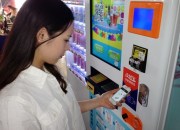
Texas based Corduro, a Google backed company, has launched a new product that allows payments sans device, card or cash! At first blush it looks like a SQUARE competitor but it seems to be targeting healthcare and larger corporations looking for scalable payment solutions. The Corduro model integrates Social Media, Online and Mobile payments, as well as POS for their all-encompassing payment solution allowing their customers to “pay by any device”.

PayMobile users can instantly pay individuals, merchants, and organizations just by being present and Enterprises can accept those payments without disruption to existing loyalty, payment, back-office or business systems and processes. A Corduro user can securely pay a Corduro retailer without physically carrying a phone, credit card, check, or cash. “We are going to demonstrate our omni-channel platform for accepting payment via any internet-connected or mobile device,” said Corduro CEO Robert Ziegler.
Read more here: http://www.sacbee.com/2013/05/08/5404468/corduro-demonstrates-a-revolution.html#storylink=cpy
Related articles
- Corduro Demonstrates a revolution in Mobile Payments at FinovateSpring 2013 (virtual-strategy.com)
- More analysts believe mobile wallets will replace cash and cards | CreditRepair.com (creditrepair.com)
- What Small Business Needs to Know About Mobile Payments (allstate.com)
- Google Wallet, Other Mobile Payments Enhance Mobile Marketing (business2community.com)
- Mobile Payment Technology: What’s in Your Digital Wallet? (webroot.com)
- Who Will Win As Mobile Payments Go Mainstream? (embargozone.com)
- Javelin Finds Mobile POS Acceptance Could Result in $1.1 Trillion in Card Payments (virtual-strategy.com)

 Although this is technically not a new technology, it is one of the fist major uses of it as a phone – to – vendor payment system. Alipay implements ultrasonic wave communication to allow commutes in Beijing, China to buy tickets using their cellphone. First launched in 2011, startup Naratte’s Zoosh tech enables mobile payments over ultrasonic sound waves. The key differentiator in this technology is that most of today’s cellphones have the required capability, that is the ability to play MP3. With a minor addition on the collector or checkout side, this is one of the cheaper technologies to implement with a much wider population of capable phones. This technology works as both payor and payee, so you can effectively use it like a “digital wallet” for phone – to – phone payments. I would be interested to know more about how they secure this system, because even though they have a unique sound for each transaction, and a 5 minute validity, I am not sure that this necessarily protects them from “man in the middle” or “record and playback” attacks. Along with the other technologies under exploration in the ‘late to catchup’ North American arena, such as NFC, QR Codes, Cloud Based Solutions, SMS, and various combinations of these, this ‘sounds’ like an interesting technology for the mobile payment space.
Although this is technically not a new technology, it is one of the fist major uses of it as a phone – to – vendor payment system. Alipay implements ultrasonic wave communication to allow commutes in Beijing, China to buy tickets using their cellphone. First launched in 2011, startup Naratte’s Zoosh tech enables mobile payments over ultrasonic sound waves. The key differentiator in this technology is that most of today’s cellphones have the required capability, that is the ability to play MP3. With a minor addition on the collector or checkout side, this is one of the cheaper technologies to implement with a much wider population of capable phones. This technology works as both payor and payee, so you can effectively use it like a “digital wallet” for phone – to – phone payments. I would be interested to know more about how they secure this system, because even though they have a unique sound for each transaction, and a 5 minute validity, I am not sure that this necessarily protects them from “man in the middle” or “record and playback” attacks. Along with the other technologies under exploration in the ‘late to catchup’ North American arena, such as NFC, QR Codes, Cloud Based Solutions, SMS, and various combinations of these, this ‘sounds’ like an interesting technology for the mobile payment space.

 Wal-Mart enters the fray with a
Wal-Mart enters the fray with a  Blackberry already released a Mobile payment solution with CIBC and Rogers using NFC for SecureTap, and announced another using a Secure Element Manager solution for NFC which is VISA approved. Blackberry have tinstalled he NFC chips on both their new models, the Z10 released earlier this year, and the Q10 due tentatively in May. No word as yet as to when applications will be released for BB10, but rumor has it that all the big banks have one in their pipeline.
Blackberry already released a Mobile payment solution with CIBC and Rogers using NFC for SecureTap, and announced another using a Secure Element Manager solution for NFC which is VISA approved. Blackberry have tinstalled he NFC chips on both their new models, the Z10 released earlier this year, and the Q10 due tentatively in May. No word as yet as to when applications will be released for BB10, but rumor has it that all the big banks have one in their pipeline.
 Apple’s new iPhone 5s will have NFC and biometric security solutions developed by Authentec and Chipbond. Rumors have it that the IPhone 5S is slotted for release in July / August 2013. Logically it makes sense that Apple will integrate the NFC and fingerprint security into the Passbook app, which only has discount coupons, tickets and some low assurance store cards.
Apple’s new iPhone 5s will have NFC and biometric security solutions developed by Authentec and Chipbond. Rumors have it that the IPhone 5S is slotted for release in July / August 2013. Logically it makes sense that Apple will integrate the NFC and fingerprint security into the Passbook app, which only has discount coupons, tickets and some low assurance store cards. The biggest question today with
The biggest question today with